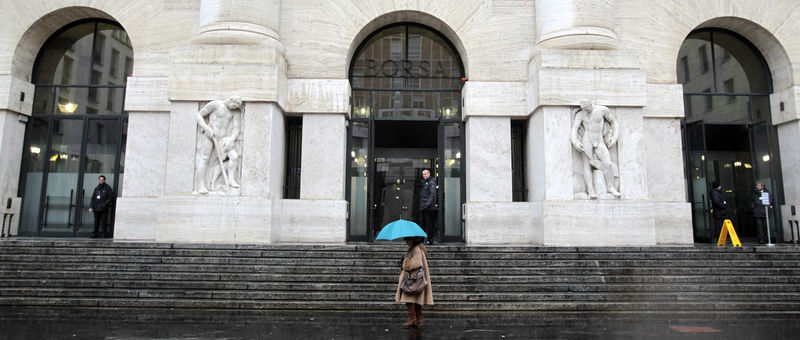By Valentina Za
MILAN (Reuters) - Falling foreign demand for Italian government bonds is pressuring domestic banks to step into the breach, as they did back in 2011-2012. Yet they may find it harder to come to the rescue of the country's debt this time around.
Foreign investors shed a net 33 billion euros ($38 billion) in Italian government bonds in June, the Bank of Italy said last week, following a 25 billion sell-off in May, spooked by pledges to ramp up spending and unwind past deficit-curbing reforms from Italy's anti-establishment coalition government.
When a similar trend developed during the euro zone crisis, home banks responded by gorging on high-yielding bonds that beefed up their revenues for years to come. The annual pace of increase in their domestic bond holdings soared to 20 percent from an average of just 1 percent in 2004-2007.
But any hopes the banks will repeat that role may be frustrated because their situation has changed since then.
"Whether domestic financial institutions will continue to act as a steady (and potentially increasing) source of demand for sovereign (debt) ... remains a fundamental question for the coming months," Goldman Sachs (NYSE:GS) analyst Matteo Crimella said in a recent note.
To be sure, banks generally favor their own country's bonds, a tendency known as "home bias". Analysts also flag that they can be subject to "moral suasion" from authorities to help out in times of stress.
But "regulatory and supervisory changes, together with the risk of a deterioration in banks' capital ratios/ratings owing to weaknesses in the sovereign market could, all together, raise the bar for domestic banks to step in as buyers," Crimella said.
Complicating Italy's task of refinancing the world's third-largest public debt, worth 2.3 trillion euros, the European Central Bank (ECB) will soon end the bond purchases it has been carrying out under its ultra-expansionary monetary policy.
MARGINAL BUYER
"With the ECB's ... purchases likely coming to an end and the risk that foreign investors will reduce further their exposure to BTP bonds, the need for a 'marginal buyer' of Italian government debt could increase," Crimella said.
"Any reluctance of domestic banks to fulfill that role could lead to a shortfall in demand, especially should the government pursue a bulky fiscal expansion."
Italian banks have stepped up purchases in the face of the recent sell-off and their holdings hit a one-year high of 370 billion euros in June, up from 342 billion in April.
Analysts at Bank of America Merrill Lynch (NYSE:BAC) estimate Italian banks have room to buy a further 44 billion euros before Italian government bonds on their balance sheet match a 2015 high of 11 percent of total assets.
That compares with 3.5 percent in 2007 before the global financial crisis and a 2015 euro area average of 4.3 percent.
Yet any buying increases risks for bank balance sheets, where the damage from Italy's falling bond prices is already apparent.
UniCredit (MI:CRDI) and Intesa (MI:ISP) both lost roughly one third of a percentage point in core capital due to the sell-off, though Intesa was able to offset the hit by issuing new shares to reward employees and by converting savings shares.
Jefferies calculated a further 0.15 to 0.20 percentage point capital erosion at Italy's top two banks this quarter, based on current bond yield levels.
REGULATORY THRESHOLDS
Italian banks have strengthened their capital in recent years and are well above regulatory thresholds, but investors are always wary of declining capital levels.
Banco BPM (MI:BAMI) suffered even more as the market turmoil shaved 0.84 percentage points off its capital, complicating bad debt disposal plans for Italy's fourth-largest bank.
Intesa Sanpaolo declined to comment, while Banco BPM and UniCredit had no immediate comment.
Any decline in capital ratios could hamper ongoing attempts to deal with a legacy of bad loans, which soared after a harsh recession and have become the focus of regulatory and investor concerns.
The ECB, which directly supervises larger Italian banks since November 2014, has made cutting bad loans a priority and banks need to preserve their capital to be able to weather the impact of disposals which are normally carried out at a loss.
Analysts say Europe-wide stress tests the European Banking Authority is conducting this year may also increase lenders' awareness of sovereign risks.
Domestic banks' willingness to mop up Italian bonds could be tested in coming months as verdicts by rating agencies loom on Rome's debt and intensifying tensions over the 2019 budget could unnerve foreign buyers.
The yield gap between Italian 10-year bonds over German Bunds has already widened to 2.8 percentage points
BofA analysts warn the premium could widen further to as much as 4 percentage points, or shrink back to 1.7 points, before the end of the year, depending on the government's next moves.
Domestic lenders therefore have plenty of risks to weigh up before continuing their recent buying spree of Italian government debt.

($1 = 0.8744 euros)